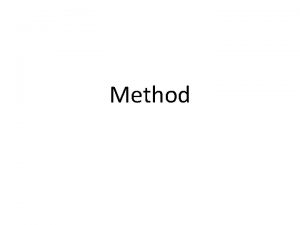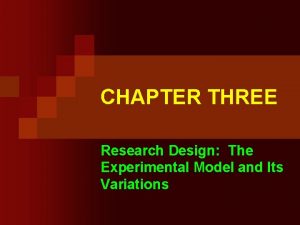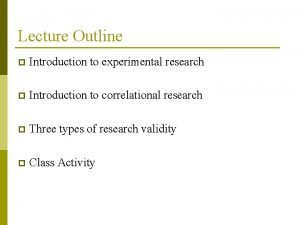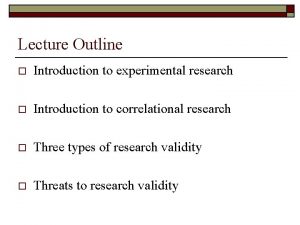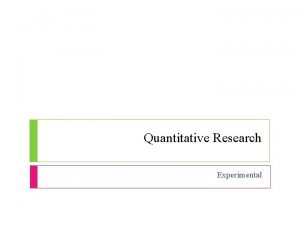Research Study Type Experimental study A study in
































- Slides: 32

Research Study

Type • Experimental study A study in which the investigator selects the levels of at least one factor • Observational study A design in which the levels of all the explanatory variables are determined as part of the observational process

Experimental design

Experimental Design a plan and a structure to test hypotheses in which the analyst controls or manipulates one or more variables Protocol for measuring the values of a set of variable It contains independent and dependent variables

Terminology Variable is a characteristic that varies (e. g. , weight, body temperature, bill length, etc. ). Treatment variable 1. the independent variable that the experimenter either controls or modifies. Factors 1. another name for the independent variables of an experimental design 2. An explanatory variable whose effect on the response is a primary objective of the study

Terminology Classification variable is the independent variable that was present prior to the experiment, and is not a result of the experimenter’s manipulations or control. Levels or Classifications are the subcategories of the independent variable used by the business analyst in the experimental design. Dependent Variable (response variable) is the response to the different levels of the independent variables.

Terminology Experimental unit 1. the unit of the study material in which treatment is applied 2. The smallest unit of the study material sharing a common treatment Observational unit (sampling unit) is the smallest unit of the study material for which responses are measured.

Populations and Samples • Population – the entire collection of values for the variable being considered. • Sample – a subset of the population. • Statistically, it is important for the sample to be a random sample.

Parameters vs. Statistics • Parameter a measure that characterizes a population. • Statistic an estimate of a population parameter, based on a sample.

Basic principles 1. Formulate question/goal in advance 2. Comparison/control 3. Replication 4. Randomization 5. Stratification (blocking) 6. Factorial experiment

Example Question: Does salted drinking water affect blood pressure (BP) in mice? Experiment: 1. Provide a mouse with water containing 1% Na. Cl. 2. Wait 14 days. 3. Measure BP.

Comparison/control Good experiments are comparative. • Compare BP in mice fed salt water to BP in mice fed plain water. • Compare BP in strain A mice fed salt water to BP in strain B mice fed salt water. Ideally, the experimental group is compared to concurrent controls (rather than to historical controls).

Replication

Why replicate? ü Reduce the effect of uncontrolled variation (i. e. , increase precision). ü Quantify uncertainty.

Randomization Experimental subjects (“units”) should be assigned to treatment groups at random. At random does not mean haphazardly. One needs to explicitly randomize using • A computer, or • Coins, dice or cards.

Why randomize? • Avoid bias. – For example: the first six mice you grab may have intrinsically higher BP. • Control the role of chance. – Randomization allows the later use of probability theory, and so gives a solid foundation for statistical analysis.

Stratification (Blocking) ü Suppose that some BP measurements will be made in the morning and some in the afternoon. ü If you anticipate a difference between morning and afternoon measurements: – Ensure that within each period, there are equal numbers of subjects in each treatment group. – Take account of the difference between periods in your analysis.

Cage positions Completely randomized design

Cage positions Randomized block design

Randomization and stratification ü If you can (and want to), fix a variable. – e. g. , use only 8 week old male mice from a single strain. ü If you don’t fix a variable, stratify it. – e. g. , use both 8 week and 12 week old male mice, and stratify with respect to age. ü If you can neither fix nor stratify a variable, randomize it.

Factorial experiments Suppose we are interested in the effect of both salt water and a high-fat diet on blood pressure. Ideally: look at all 4 treatments in one experiment. Why? Plain water Salt water× Normal diet High-fat diet – We can learn more. – More efficient than doing all single-factor experiments.

Interactions

Other points • Blinding – Measurements made by people can be influenced by unconscious biases. – Ideally, dissections and measurements should be made without knowledge of the treatment applied. • Internal controls – It can be useful to use the subjects themselves as their own controls (e. g. , consider the response after vs. before treatment). – Why? Increased precision.

Other points • Representativeness – Are the subjects/tissues you are studying really representative of the population you want to study? – Ideally, your study material is a random sample from the population of interest.

Significance test ü Compare the BP of 6 mice fed salt water to 6 mice fed plain water. ü = true difference in average BP (the treatment effect). ü H 0: = 0 (i. e. , no effect) ü Test statistic, D. ü If |D| > C, reject H 0. ü • C chosen so that the chance you reject H 0, if H 0 is true, is 5% Distribution of D when = 0

Statistical power Power = The chance that you reject H 0 when H 0 is false (i. e. , you [correctly] conclude that there is a treatment effect when there really is a treatment effect).

Power depends on… üThe structure of the experiment üThe method for analyzing the data üThe size of the true underlying effect üThe variability in the measurements üThe chosen significance level ( ) üThe sample size Note: We usually try to determine the sample size to give a particular power (often 80%).

Effect of sample size 6 per group: 12 per group:

Various effects ü Desired power sample size ü Stringency of statistical test size ü Measurement variability ü Treatment effect sample size

Determining sample size The things you need to know: • • Structure of the experiment Method for analysis Chosen significance level, (usually 5%) Desired power (usually 80%) • Variability in the measurements – if necessary, perform a pilot study • The smallest meaningful effect

Reducing sample size • Reduce the number of treatment groups being compared. • Find a more precise measurement (e. g. , average time to effect rather than proportion sick). • Decrease the variability in the measurements. – Make subjects more homogeneous. – Use stratification. – Control for other variables (e. g. , weight). – Average multiple measurements on each subject.

Final conclusions ü Experiments should be designed. ü Good design and good analysis can lead to reduced sample sizes. ü Consult an expert on both the analysis and the design of your experiment.
 Experimental vs non experimental research
Experimental vs non experimental research Research instrument in experimental research
Research instrument in experimental research Research instrument in experimental research
Research instrument in experimental research Experimental vs non experimental
Experimental vs non experimental Research approaches and designs
Research approaches and designs Experimental vs nonexperimental
Experimental vs nonexperimental Experimental vs non experimental
Experimental vs non experimental Crossover design slideshare
Crossover design slideshare Non experimental research design
Non experimental research design Disadvantage of quasi experimental design
Disadvantage of quasi experimental design Ano ang basic research
Ano ang basic research Mini research report sample
Mini research report sample Variabel sekunder adalah
Variabel sekunder adalah Non experimental correlational design
Non experimental correlational design Random assignment vs selection
Random assignment vs selection Descriptive vs correlational vs experimental research
Descriptive vs correlational vs experimental research Case control vs retrospective cohort
Case control vs retrospective cohort Classic experimental design
Classic experimental design Steps in experimental research
Steps in experimental research Matching by holding variables constant
Matching by holding variables constant 2x3 within subjects design
2x3 within subjects design Tahapan penelitian dalam psikologi
Tahapan penelitian dalam psikologi Non-experimental quantitative research
Non-experimental quantitative research Extraneous variable example
Extraneous variable example Ethical issues in experimental research
Ethical issues in experimental research Causal correlational research
Causal correlational research Operational definition of anger
Operational definition of anger Types of quantitative research designs
Types of quantitative research designs Quasi experiment
Quasi experiment Cross-sectional correlational design
Cross-sectional correlational design Operational definition psychology
Operational definition psychology Weaknesses of experimental research
Weaknesses of experimental research Chapter 4 experimental research
Chapter 4 experimental research


